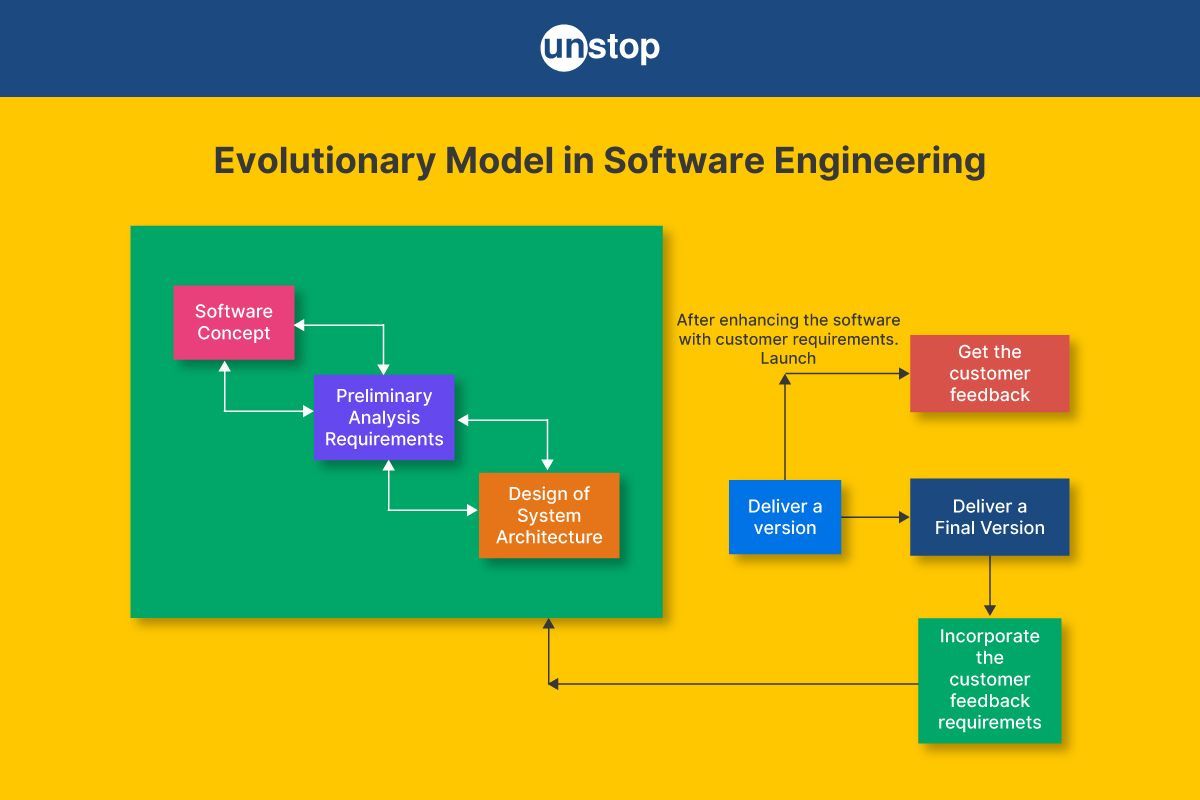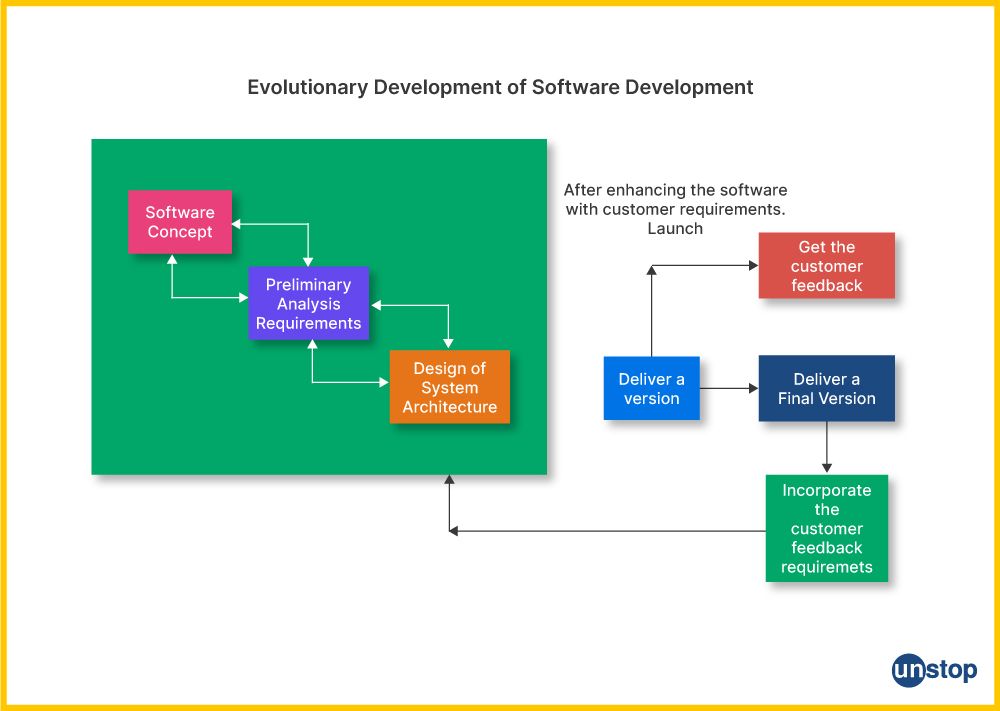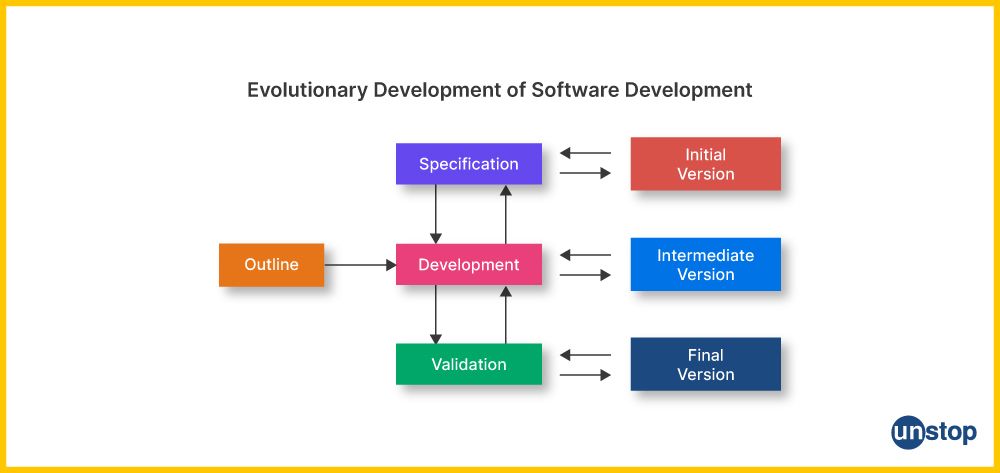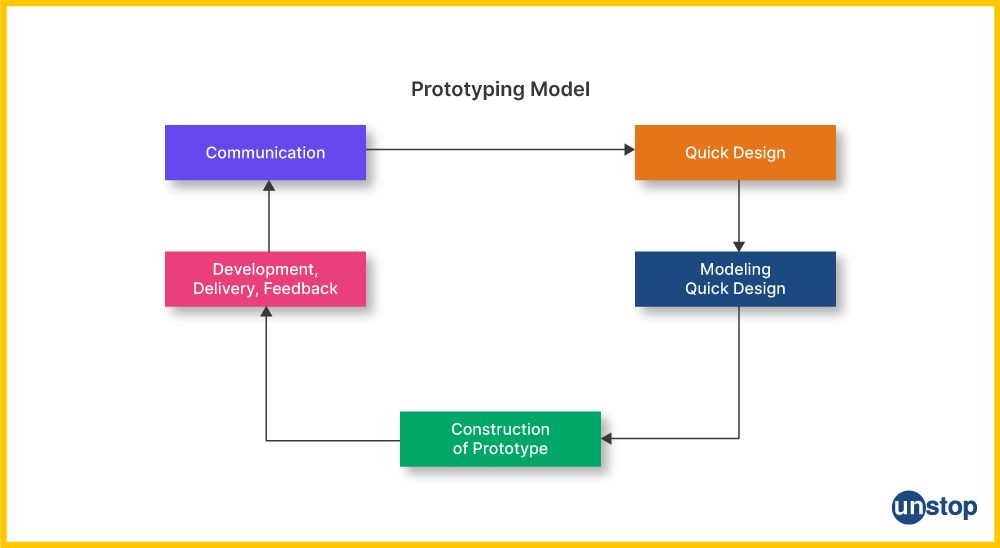- What Is An Evolutionary Model In Software Engineering?
- Advantages And Disadvantages Of Evolutionary Models In Software Engineering
- Types Of Evolutionary Models In Software Engineering
- Prototyping Model
- Spiral Model
- Concurrent Model
- Applications Of Evolutionary Model
- Conclusion
- Frequently Asked Questions
Evolutionary Model In Software Engineering | Types, Examples & More

Before we dive deep into understanding the evolutionary model in software engineering, let’s first understand how complex tasks can be made simpler. To make work simpler and more efficient it is always better to divide it into small sections or modules.
Let’s take a real-life example: you have started preparing for competitive exams such as Civil Services. How will you proceed? It’s simple:
- You will first develop a clear-cut idea about the syllabus.
- You will then start with the basic concepts.
- Next, you will then move to gaining expertise on more advanced concepts.
- You figure out your mistakes by giving mock tests.
- Eventually, you attempt the final exam and complete the goal.
Confused about “how does this relates to the evolutionary model?”. Much like the complex and lengthy syllabus of a Civil Service exam, software requirements are often fragmented into several chunks. These chunks can be built and transferred incrementally.
In other words, you develop a skeleton of the product, and in successive versions, add more functionalities. Services are not required for the core module (first stage) of the system. This iterative waterfall model is used to develop an evolutionary model.
In simple words, “Iterative” + “Incremental model” = Evolutionary model.

What Is An Evolutionary Model In Software Engineering?
Evolutionary models in software engineering are iterative and incremental approaches that allow for the development of software systems through a series of iterations or releases. These models emphasize adaptability and flexibility, allowing for changes to be made throughout the development process.
An evolutionary model involves breaking down the software development process into smaller, manageable increments or iterations. Each iteration involves the completion of a subset of the overall software requirements, allowing for continuous testing, feedback, and refinement. This approach enables the software to evolve and improve over time, as new requirements and insights emerge.

The evolutionary model is particularly beneficial in software projects where the initial requirements are not fully understood or may change during the development process. It allows for flexibility and adaptability, enabling the development team to respond to changes effectively. By continuously refining and enhancing the software through iterative development, the evolutionary process model helps ensure that the end product meets the evolving needs and expectations of the stakeholders.
Real-Life Example
Let’s take the case of an education learning app launched in the Google Play Store as a pre-release (beta version) before being fully developed for customer use. You might wonder why this approach is taken. Let’s break it down:
- You install the pre-release version of the app.
- While using the app, you occasionally encounter bugs or issues.
- You leave feedback in the review section of the Google Play Store.
- The technical team reviews your feedback and reports the bug issues and improvement suggestions to the development team.
- Shortly after, the app prompts you to install an update. The update notes might state something like: Bug fixes, Feature improvements, etc.
- A revised version of the app is released, addressing the bugs and possibly adding new features to decrease the chances of errors. Based on ongoing customer feedback, future versions will continue to evolve to meet user needs.

Advantages And Disadvantages Of Evolutionary Models In Software Engineering
One major advantage of the evolutionary model is its flexibility. This model allows for changes and adaptations to be made throughout the development process, which can be beneficial in situations where initial project requirements are uncertain or likely to change. This flexibility enables the development team to respond to feedback and make adjustments as needed, resulting in a final product that better meets the user requirements/ needs of the stakeholders.
However, a major disadvantage of the evolutionary model is the potential for scope creep. Because this model allows for changes and additions to be made throughout the development process, there is a risk of the project expanding beyond its initial scope. This can lead to increased costs, delays, and a loss of focus on the original objectives. It requires careful management and control to prevent scope creep and ensure that the project stays on track.
Here are the other major advantages and disadvantages of the evolutionary model in software engineering:
| Advantages | Disadvantages |
| Allows for incremental development and improvement | May require more time and effort to manage and coordinate changes |
| Enables early delivery of working software | Requires a high level of collaboration and communication among team members |
| Facilitates continuous feedback and collaboration with stakeholders | May not be suitable for projects with strict deadlines or fixed budgets |
| Reduces the risk of project failure by identifying issues early on | This can result in a less predictable and more uncertain development process |
Types Of Evolutionary Models In Software Engineering
The three main types of evolutionary models in software engineering are:
- Prototype model
- Spiral model
- Concurrent model
We will discuss these models, along with their advantages, disadvantages and examples in detail in the sections ahead.
Looking for mentors? Find the perfect mentor for select experienced coding & software experts here.
Prototyping Model
The prototype model is a software development approach that involves creating an initial, working version of an actual product to gather feedback and make improvements. This model is particularly useful when requirements are not well-defined or may change throughout the development process.
- The prototype serves as a visual representation of the final product, allowing stakeholders to provide feedback and suggest changes before the full development begins.
- It helps identify potential issues early on and reduces the risk of developing a product that does not meet the user requirements/ needs. The prototype model promotes collaboration and iterative development, with multiple iterations of prototyping and refining until the final product is achieved.
- The prototype model only provides the initial implementation. Initial implementation deals with the objective of the software product. Input and output requirements are not dealt with in this model. It also does not provide multiple functionalities. In other words, it’s an initial product skeleton.
Here are the major phases of a prototyping model:
- Communication: Developer and customer interact on the objectives for software products.
- Quick Design: A detailed plan is not visible; rather this phase helps the developer to work on the prototype with active user involvement.
- Modeling Quick Design: Software is developed, allowing the developer to understand the exact niche requirements.
- Construction of prototype: Customer evaluates the prototype
- Delivery time, deployment, and feedback: The application is launched and actual user feedback is received. Post this, issues, if any, are fixed by the developer team.

Advantages Of Prototyping Model
- This model calls for active user involvement. The stakeholder/ customer plays a vital role in the development of the application. They contribute to it through, -->Customer response, customer evaluation, and customer feedback where they intimate issues to the development team. The developer team can then sort out the problem.
- Resolving response time is quick.
- Project risk can be avoided and the project team can improvise according to the feedback from users.
- This model allows a greater degree of customer involvement, which helps improve product quality.
Disadvantages Of Prototyping Model
- Time-consuming: Multiple tickets reported by the customer can be tedious and disrupt the flow of the development team, leading to slow evolvement sometimes.
- Scope: If the prototype is constantly changing, it can be difficult to manage the scope of the project.
- There is a risk that the prototype will become the final product, even if it is not satisfactory to the users and stakeholders.
Example Of Prototype Model
An example of a prototype model is a mock-up of a new mobile application. Let's say a software development team is tasked with creating a new social media app.
- Before investing time and resources into building the full application, they may create a prototype model to test the concept and gather feedback.
- This prototype model could be a simplified version of the app with basic features and a user interface that allows users to navigate through different screens.
- The team can then share this prototype with potential users or stakeholders to get their input and make any necessary adjustments before progressing with the development process.
- By using a prototype model, the team can save time and resources by identifying any potential issues or improvements early on in the design phase.
Spiral Model

The spiral model is a software development process that combines elements of both the waterfall and iterative models. It is characterized by a series of iterations, or spirals, where each spiral represents a phase in the software development life cycle (SDLC).
The model is based on the idea of risk management, with the project divided into smaller iterations. Each iteration includes the following phases:
- Planning: Identifying objectives, alternatives, and constraints.
- Risk analysis: Identifying risks and formulating strategies to address them.
- Development: Designing, coding, and testing the system.
- Evaluation: Review the work completed in that iteration to refine the system based on feedback.
The spiral model allows flexibility, as changes can be made at each iteration based on the evaluation and feedback from the previous spiral. This iterative nature/ approach helps in managing risks effectively and ensures that the final product aligns with the desired requirements.
Spiral Model = Concept of Waterfall Lifecycle + Iterative Model
Advantages Of Spiral Model
- Focuses heavily on risk assessment and mitigation.
- Early versions of the software can be developed for feedback and refinement.
- Primarily suited for large, complex and high-risk projects with evolving requirements.
- Allows for documentation control and tracking of progress.
- Provides room for alternate solutions when risks are identified.
- Ensures alignment with user needs and business goals after each iteration.
Disadvantages Of Spiral Model
- It can be complex and difficult to manage due to multiple iterations.
- It can be time-consuming and expensive.
- It is not suitable for small and simple projects.
- It can be difficult sometimes to estimate the cost of development and schedule of a spiral project.
Example Of Spiral Model
A typical example of the spiral model is the development of a new software application. The process begins by identifying the project’s objectives and requirements.
- The development team creates an initial prototype of the software, which is reviewed by stakeholders and select users.
- Based on the feedback, the team refines the prototype in the next iteration of the spiral, where they refine and enhance the prototype.
- This iterative/ incremental process continues, with each spiral iteration incorporating feedback and improvements, ensuring that the final product meets the stakeholders' needs.
Concurrent Model
The concurrent model of software development refers to a programming model that allows multiple tasks or processes to run simultaneously or in parallel. In this model, tasks are executed concurrently, meaning they can overlap in execution and make progress independently, without waiting for others to finish.
- This is typically achieved by dividing a program into smaller functional units of work, known as threads or processes, which can run concurrently.
- Each thread executes its own set of instructions, and threads can communicate with each other to share data and synchronize activities.
- The concurrent development model is commonly used in multi-core processors and parallel computing systems to efficiently utilize resources and improve performance.
- It is particularly useful for tasks that can be divided into smaller independent units and require efficient system resource management, such as real-time systems, web servers, and scientific computing.
Advantages Of Concurrent Model
- Efficient resource utilization, especially in multi-core systems.
- Enables faster execution of independent tasks through parallelism.
- Improves system responsiveness and throughput for I/O-bound and CPU-bound tasks.
Disadvantages Of Concurrent Model
- Requires clear and constant communication between development team members for synchronization and coordination.
- Managing concurrency is complex due to race conditions, deadlocks, and the need for synchronization mechanisms (e.g., locks, semaphores).
- Debugging and maintaining concurrent systems can be more challenging. This is because there is a greater chance of errors and inconsistencies occurring when multiple phases of the SDLC are happening simultaneously.
- It may require more resources, increasing the cost of managing and coordinating multiple concurrent tasks.
Example Of Concurrent Model
Consider the development of a large-scale online e-commerce platform. In this project, different teams work on various components of the system simultaneously to leverage the benefits of concurrent processing.
- Frontend Development Team: Works on creating and refining the user interface, including product pages, shopping carts, and checkout processes.
- Backend Development Team: Develops the server-side logic, database interactions, and API integrations required to handle transactions, user accounts, and inventory management.
- Testing Team: Concurrently tests different modules of the application, including performance, security, and usability testing.
Applications Of Evolutionary Model
The evolutionary model has various applications in different fields. Some of the key applications include:
- Software Development: The evolutionary model is widely used in software development to manage and adapt to changing requirements. It allows for iterative development, where the software is developed in increments and evolves over time based on user feedback and evolving needs.
- Product Design: The evolutionary model is often employed in product design to create innovative and user-centric products. By continuously refining and improving the design based on user feedback and market trends, designers can create products that better meet the needs and preferences of their target audience.
- Biological Research: The evolutionary model is fundamental to the field of biology. It helps scientists understand the processes of natural selection, adaptation, and speciation. By studying the evolution of species over time, researchers can gain insights into the origins and development of life on Earth.
- Marketing and Advertising: The evolutionary model is increasingly being used in marketing and advertising strategies. By continuously testing and optimizing different marketing approaches, companies can evolve their campaigns to better resonate with their target audience and improve their overall marketing effectiveness.
- Organizational Change: The evolutionary model can also be applied to organizational change and project management. By embracing a gradual and iterative approach to change, organizations can adapt and evolve their processes, systems, and culture over time, minimizing resistance and maximizing the chances of successful change implementation.
- Artificial Intelligence: The principles of the evolutionary model are often utilized in artificial intelligence algorithms. Evolutionary algorithms, such as genetic algorithms and genetic programming, mimic the process of natural selection to solve complex optimization problems, design neural networks, and create intelligent systems.
Conclusion
The evolutionary model in software development offers a flexible and adaptive approach, allowing teams to respond to changing requirements and evolving user needs. By breaking down the development process into iterative cycles, this model encourages continuous feedback and improvement, ensuring that the software evolves over time to better align with its intended purpose.
This iterative/ incremental model is primarily used for large projects or projects where the customer wants access to core features early, rather than waiting for the entire software package to be completed. It is also widely applied in object-oriented software development. The flexibility and adaptability of the evolutionary model make it a valuable tool across various domains, supporting continuous improvement and innovation.
Frequently Asked Questions
Q. What are the advantages of using evolutionary models?
The advantages of using evolutionary models are:
- Adaptability: Easily accommodates changing requirements and evolving user needs.
- Early feedback: Continuous user feedback helps identify and address issues early.
- Risk reduction: Iterative development allows for early risk identification and mitigation.
- Incremental delivery: Core functionalities are delivered early, with further features added over time.
- Improved collaboration: Frequent interaction between developers and stakeholders ensures better alignment with project goals.
- Flexibility: Suited for large, complex projects and environments with dynamic requirements.
Q. What are evolutionary models in software engineering?
Evolutionary models in software engineering are iterative and incremental approaches to software development. These models emphasize the continuous evolution and refinement of software through multiple iterations. They allow for flexibility and adaptability in the development process, enabling the incorporation of changes and improvements based on feedback and evolving requirements.
Q. What are the different types and examples of evolutionary models?
Agile methodologies, such as Scrum and Kanban, are popular examples of evolutionary models. These models prioritize adaptability, collaboration, and frequent iterations. They promote close interaction between developers and stakeholders, enabling rapid responses to changing requirements. There are also several types of evolutionary models in software engineering, including:
-
Prototyping Model: This model involves the creation of a prototype that serves as a basis for refining the final software product. It allows for early user feedback and helps in identifying and resolving potential issues.
-
Spiral Model: The spiral model combines elements of both waterfall and prototyping models. It follows an iterative approach, with each iteration consisting of four phases: architectural planning, risk analysis, engineering, and evaluation. This model emphasizes risk management and allows for continuous refinement throughout the development process.
Q. How do evolutionary models differ from traditional models?
Evolutionary models differ from traditional models, such as the waterfall model, in several ways:
| Aspect | Evolutionary Model | Traditional Model (e.g., Waterfall) |
|---|---|---|
| Development Approach | Iterative nature and incremental, allowing for gradual improvements and adaptation | Sequential and linear, with fixed stages that must be completed before moving on |
| Requirement Flexibility | High flexibility; requirements can evolve and change over time | Low flexibility; requirements are fixed early in the development process |
| Feedback Incorporation | Continuous user feedback is integrated throughout the model of the development cycle | Feedback is typically gathered only after the product is fully developed |
| Risk Management | Reduced risk by addressing issues early in each iteration | Higher risk due to the late detection of potential issues in later stages |
| Time to Market | Early core functionality delivered, with feature sets added in subsequent iterations | Full system delivered at the end of the development cycle |
| Project Size Suitability | Best suited for large, complex, or evolving projects | Suitable for smaller, well-defined projects with stable requirements |
| Customer Involvement | High involvement; customers provide feedback during each iteration | Limited involvement of customers during development. They provide feedback after the development is completed |
| Cost of Change | Lower, as changes can be implemented during iterative phases | Higher, as changes late in the cycle may require significant rework |
| Testing | Ongoing testing throughout each iteration, ensuring stability over time | Testing typically occurs after all development stages are completed |
| Adaptability | Highly adaptive to new technologies, market changes, and user needs | Less adaptive, as the structure is rigid and predetermined |
| Documentation | Evolving documentation updated with each iteration | Extensive documentation completed upfront before development begins |
| Delivery | Partial delivery of working software in early iterations | Full delivery of the product only at the end of the development cycle |
Q. How does user feedback influence the development of operating systems using the evolutionary model?
User feedback plays a crucial role in the development of operating systems using the evolutionary model by:
- Guiding improvements: Feedback helps identify issues, bugs, or missing features, allowing software developers to make necessary adjustments and enhancements in future iterations.
- Prioritizing features: Developers can prioritize new features or updates based on user needs and preferences, ensuring the operating system evolves in a user-centric way.
- Enhancing usability: Continuous feedback enables refinements that improve the overall user experience, ensuring the system meets real-world usage patterns.
- Ensuring relevance: By integrating user suggestions, the operating system remains adaptable to new hardware, software, and evolving user demands, making it more competitive and up-to-date.
You might also be interested in reading:
As a biotechnologist-turned-writer, I love turning complex ideas into meaningful stories that inform and inspire. Outside of writing, I enjoy cooking, reading, and travelling, each giving me fresh perspectives and inspiration for my work.
Login to continue reading
And access exclusive content, personalized recommendations, and career-boosting opportunities.
Subscribe
to our newsletter
















Comments
Add comment